CHEVROLET BLAZER 1998 2.G Owners Manual
Manufacturer: CHEVROLET, Model Year: 1998, Model line: BLAZER, Model: CHEVROLET BLAZER 1998 2.GPages: 416, PDF Size: 22.4 MB
Page 231 of 416
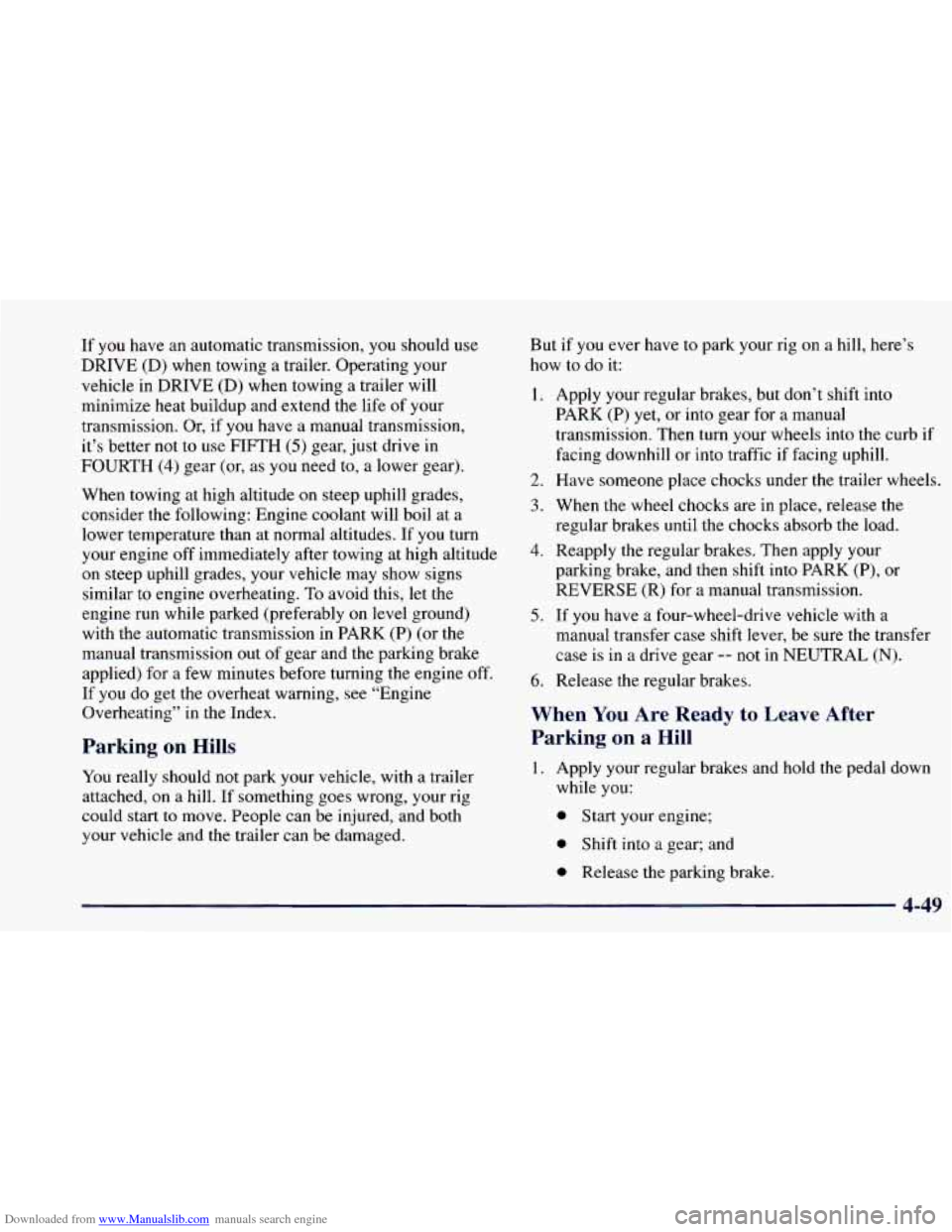
Downloaded from www.Manualslib.com manuals search engine If you have an automatic transmission, you should use
DRIVE
(D) when towing a trailer. Operating your
vehicle in DRIVE (D) when towing a trailer will
minimize heat buildup and extend the life
of your
transmission. Or, if
you have a manual transmission,
it’s better not to use
FIFTH (5) gear, just drive in
FOURTH
(4) gear (or, as you need to, a lower gear).
When towing at high altitude on steep uphill grades,
consider the following: Engine coolant will boil at a
lower temperature than at normal altitudes. If
you turn
your engine off immediately after towing at high altitude
on steep uphill grades, your vehicle may show signs
similar to engine overheating.
To avoid this, let the
engine run while parked (preferably
on level ground)
with the automatic transmission in PARK (P) (or the
manual transmission out
of gear and the parking brake
applied) for a few minutes before turning the engine
off.
If you do get the overheat warning, see “Engine
Overheating” in the Index.
Parking on Hills
You really should not park your vehicle, with a trailer
attached,
on a hill. If something goes wrong, your rig
could start
to move. People can be injured, and both
your vehicle and the trailer can be damaged. But if you ever have
to park your rig
on a hill, here’s
how
to do it:
1.
2.
3.
4.
5.
6.
Apply your regular brakes, but don’t shift into
PARK
(P) yet, or into gear for a manual
transmission. Then turn your wheels into the curb if
facing downhill or into traffic if facing uphill.
Have someone place chocks under the trailer wheels.
When the wheel chocks are in place, release the
regular brakes until the chocks absorb the load.
Reapply the regular brakes. Then apply your
parking brake, and then shift into PARK (P), or
REVERSE
(R) for a manual transmission.
If
you have a four-wheel-drive vehicle with a
manual transfer case shift lever, be sure the transfer
case is
in a drive gear -- not in NEUTRAL (N).
Release the regular brakes.
When You Are Ready to Leave After
Parking on a Hill
1. Apply your regular brakes and hold the pedal down
while you:
0 Start your engine;
0 Shift into a gear; and
0 R.elease the parking brake.
4-49
Page 232 of 416
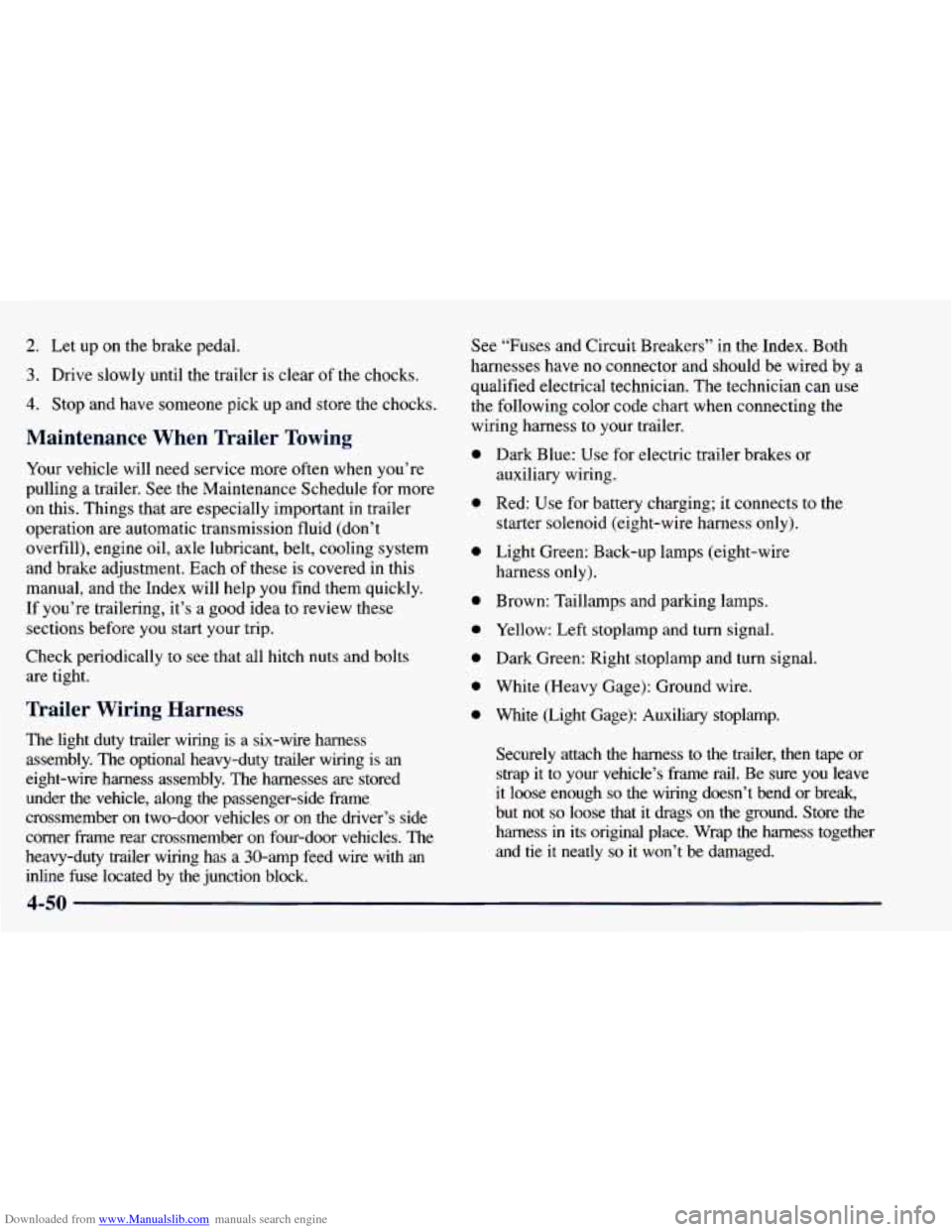
Downloaded from www.Manualslib.com manuals search engine 2. Let up on the brake pedal.
3. Drive slowly until the trailer is clear of the chocks.
4. Stop and have someone pick up and store the chocks.
Maintenance When Trailer Towing
Your vehicle will need service more often when you’re
pulling
a trailer. See the Maintenance Schedule for more
on this. Things that are especially important
in trailer
operation are automatic transmission fluid (don’t
overfill), engine oil, axle lubricant, belt, cooling system
and brake adjustment. Each
of these is covered in this
manual, and the Index will help
you find them quickly.
If
you’re trailering, it’s a good idea to review these
sections before you start your trip.
Check periodically to see that all hitch nuts and bolts
are tight.
Trailer Wiring H-T--- ess
The light duty trailer wir is a six-wire harness
assembly. The optional heavy-duty trailer wiring
is an
eight-wire harness assembly. The harnesses are stored under the vehicle, along the passenger-side frame
crossmember on two-door vehicles or on the driver’s side
corner frame rear crossmember on four-door vehicles. The
heavy-duty trailer wiring has a 30-amp feed wire with
an
inline fuse located by the junction block. See
“Fuses and Circuit Breakers” in the Index. Both
harnesses have
no connector and should be wired by a
qualified electrical technician. The technician
can use
the following color code chart when connecting the
wiring harness to your trailer.
0
0
0
0
0
0
0
0
Dark Blue: Use for electric trailer brakes or
auxiliary wiring.
Red: Use for battery charging; it connects to the
starter solenoid (eight-wire harness only).
Light Green: Back-up lamps (eight-wire
harness only).
Brown: Taillamps and parking lamps. Yellow: Left stoplamp and turn signal.
Dark Green: Right stoplamp and turn signal.
White (Heavy Gage): Ground wire.
White (Light Gage): Auxiliary stoplamp.
Securely attach the harness to the trailer, then tape or
strap
it to your vehicle’s frame rail. Be sure you leave
it loose enough
so the wiring doesn’t bend or break,
but not
so loose that it drags on the ground. Store the
harness in its original place. Wrap the harness together
and tie it neatly
so it won’t be damaged.
Page 233 of 416
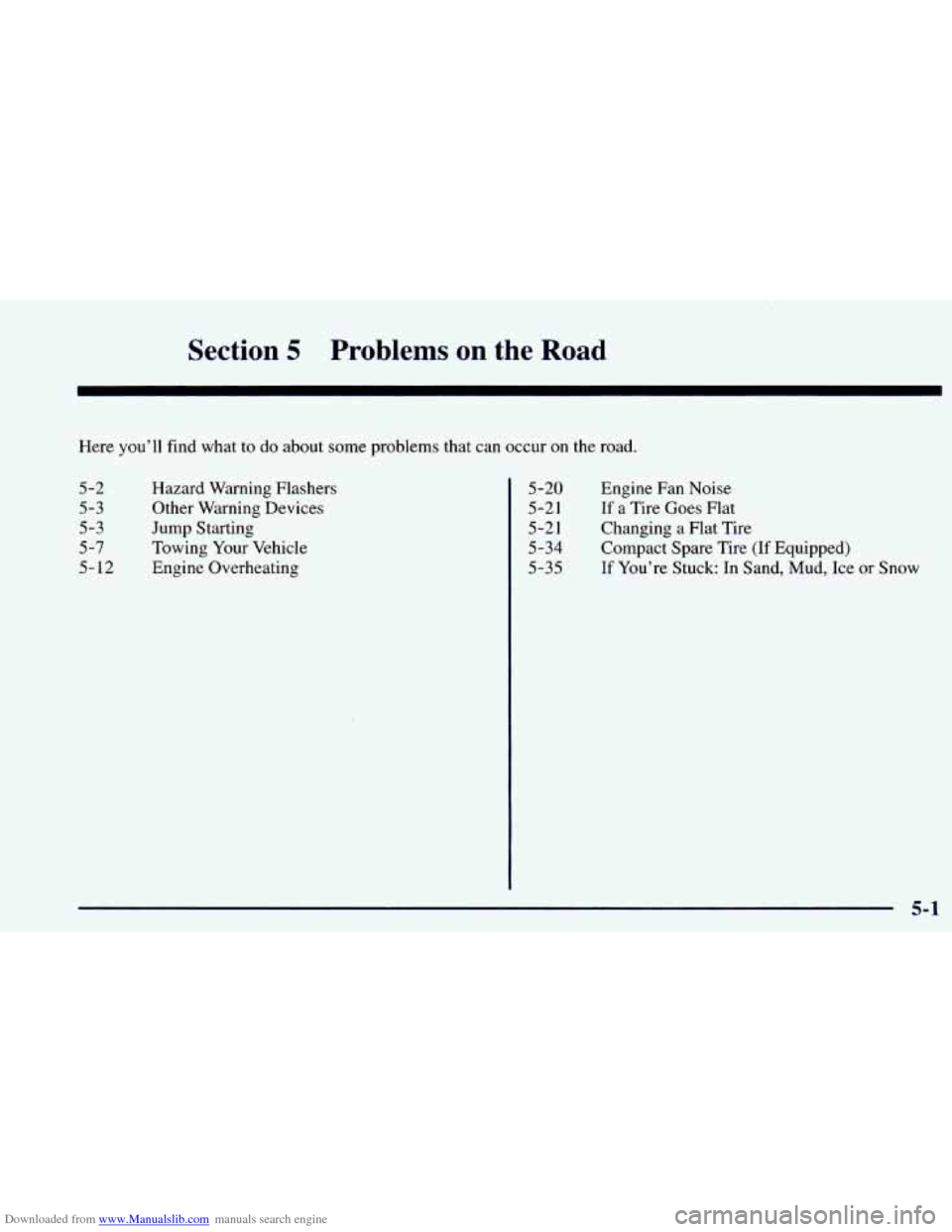
Downloaded from www.Manualslib.com manuals search engine Section 5 Problems on the Road
Here you’ll find what to do about some problems that can occur on the road.
5-2
5-3
5-3
5 -7
5- 12 Hazard Warning
Flashers
Other Warning Devices
Jump Starting
Towing Your Vehicle
Engine Overheating
5 -20
5-2 1
5-2 1
5-34
5-35
Engine Fan Noise
If
a Tire Goes Flat
Changing a Flat Tire
Compact Spare Tire
(If Equipped)
If You’re Stuck:
In Sand, Mud, Ice or Snow
5-1
Page 234 of 416
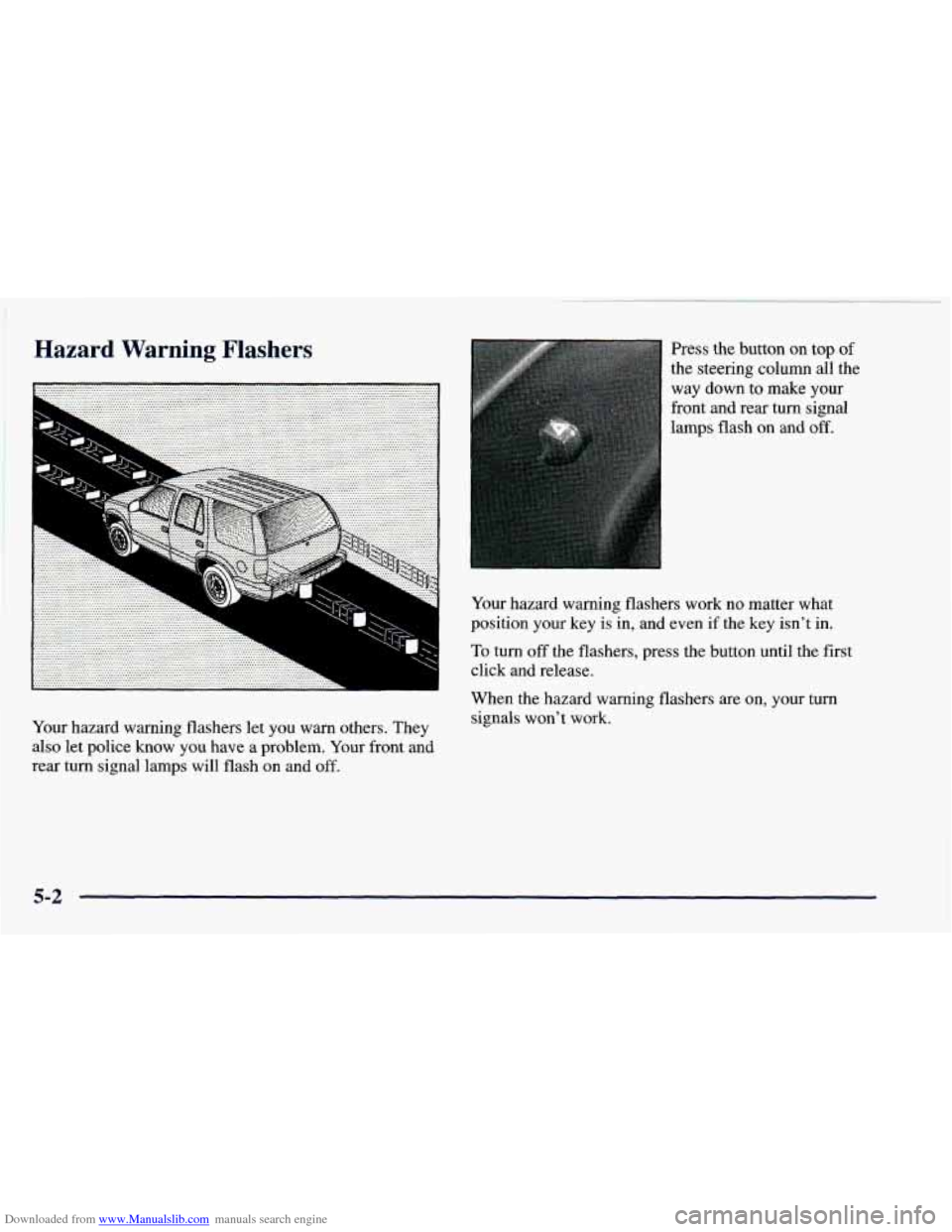
Downloaded from www.Manualslib.com manuals search engine Hazard Warning Flashers
. . .q .. ..
Your hazard warning flashers let you warn others. They
also let police
know you have a problem. Your front and
rear turn signal lamps will flash on and
off.
Press the button on top of
the steering column all the
way down to make your
front and rear turn signal
lamps flash on and
off.
Your hazard warning flashers work no matter what
position your key
is in, and even if the key isn’t in,
To turn off the flashers, press the button until the first
click and release.
When the hazard warning flashers are on, your turn
signals won’t work.
5-2
Page 235 of 416
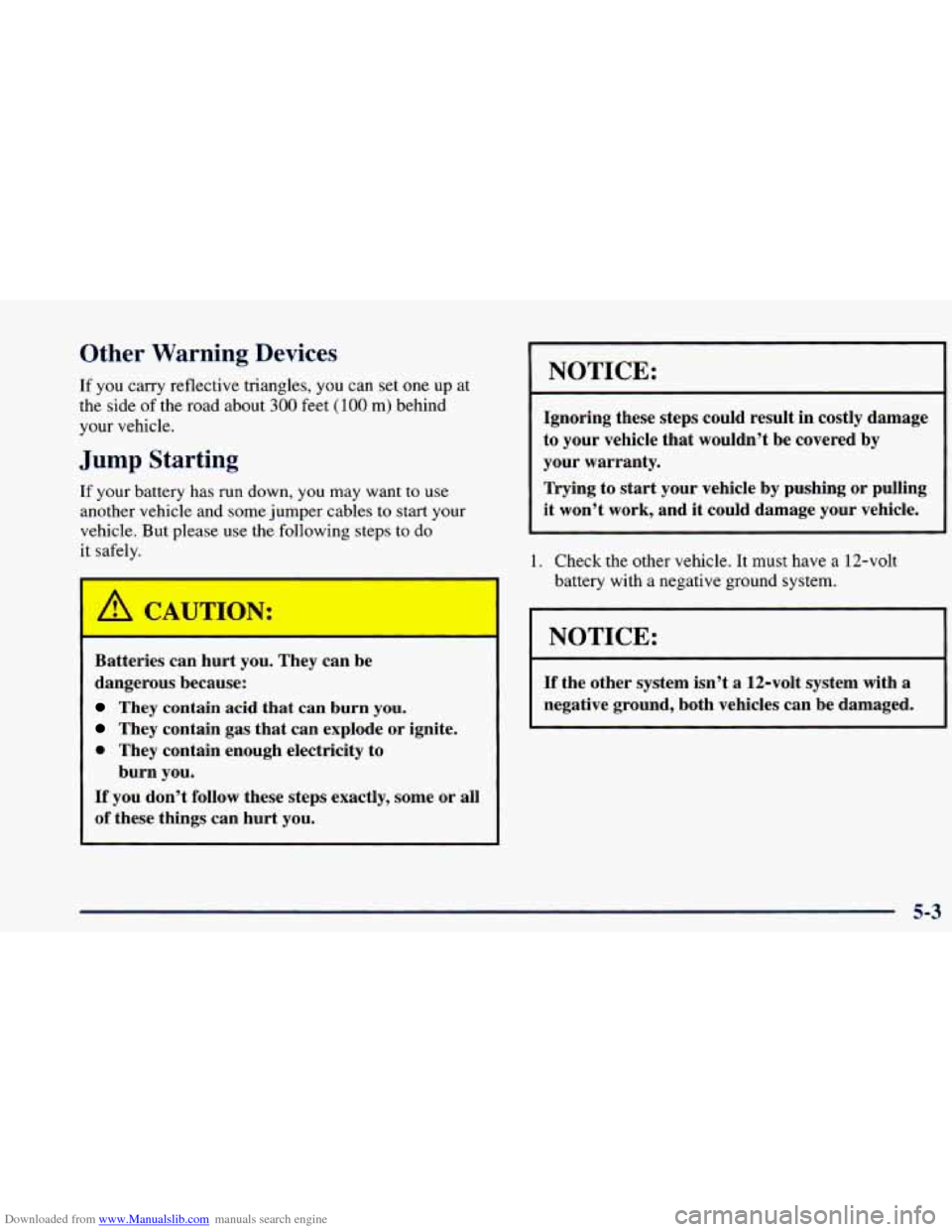
Downloaded from www.Manualslib.com manuals search engine Other Warning Devices
If you carry reflective triangles, you can set one up at
the side
of the road about 300 feet (100 m) behind
your vehicle.
Jump Starting
If your battery has run down, you may want to use
another vehicle and some jumper cables to start your
vehicle. But please use the following steps to do
it safely.
IJTTT’Jr
-
Batteries can nurr you. They can De
dangerous because:
They contain acid that can burn you.
They contain gas that can explode or ignite.
0 They contain enough electricity to
If you don’t follow these steps exactly, some or all
of these things can hurt you.
burn
you.
I
NOTICE:
Ignoring these steps could result in costly damage
to your vehicle that wouldn’t be covered by
your warranty.
Trying to start your vehicle by pushing or pulling
it won’t work, and
it could damage your vehicle.
I. Check the other vehicle. It must have a 12-volt
battery
with a negative ground system.
NOTICE:
If the other system isn’t a 12-volt system with a
negative ground, both vehicles can be damaged.
I
5-3
Page 236 of 416
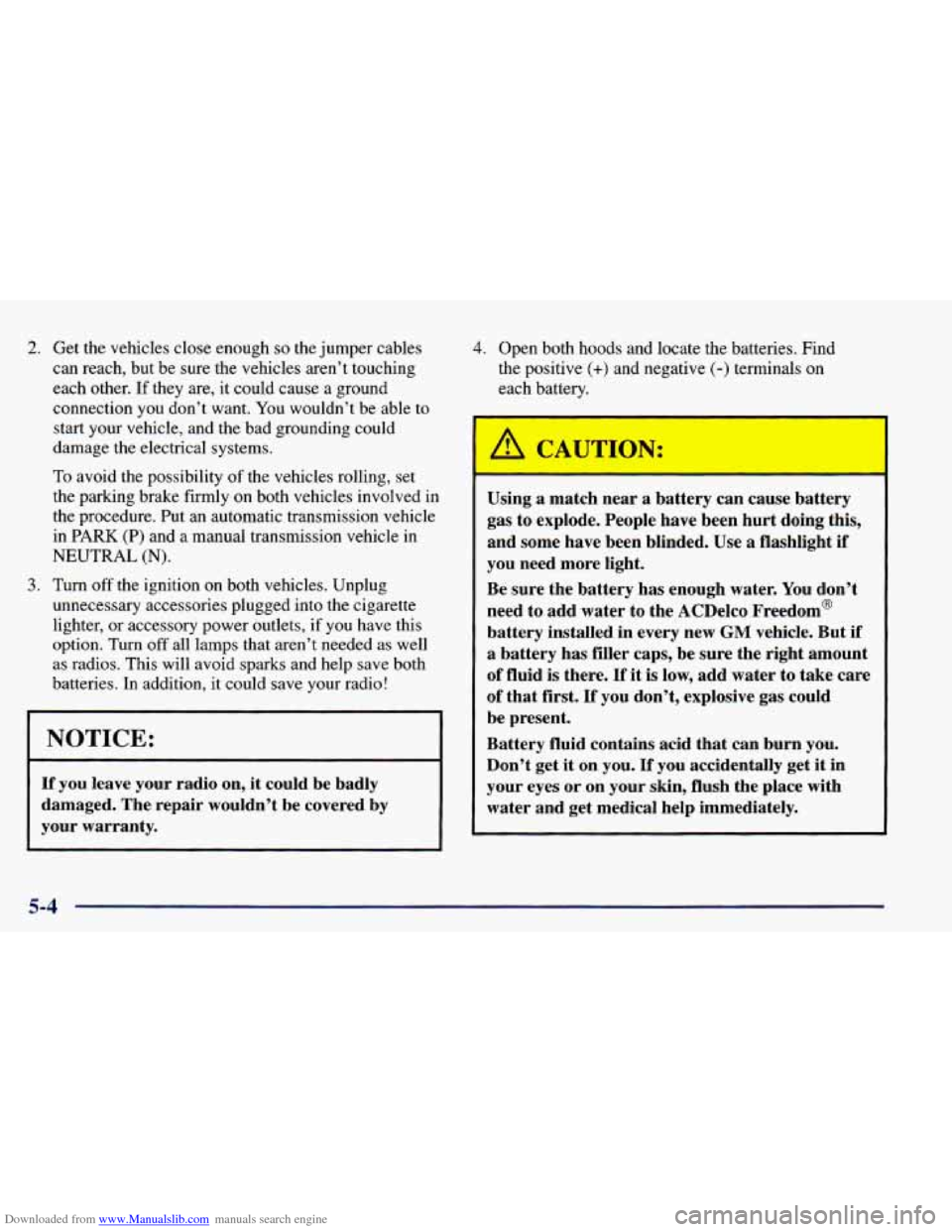
Downloaded from www.Manualslib.com manuals search engine 2. Get the vehicles close enough so the jumper cables
can reach, but be sure the vehicles aren’t touching
each other.
If they are, it could cause a ground
connection you don’t want. You wouldn’t be able to
start your vehicle, and the bad grounding could
damage the electrical systems.
To avoid the possibility of the vehicles rolling, set
the parlung brake firmly on both vehicles involved in
the procedure. Put an automatic transmission vehicle
in
PARK (P) and a manual transmission vehicle in
NEUTRAL (N).
3. Turn off the ignition on both vehicles. Unplug
unnecessary accessories plugged into the cigarette
lighter, or accessory power outlets, if you have this
option. Turn off all lamps that aren’t needed as well
as radios. This will avoid sparks and help save both
batteries. In addition, it could save your radio!
NOTICE:
If you leave your radio on, it could be badly
damaged. The repair wouldn’t be covered
by
your warranty.
4. Open both hoods and locate the batteries. Find
the positive
(+) and negative (-) terminals on
each battery.
AUTION:
I
Using a match near a battery can cause battery
gas to explode. People have been hurt doing this,
and some have been blinded.
Use a flashlight if
you need more light.
Be sure the battery has enough water.
You don’t
need to add water to the ACDelco Freedom@
battery installed in every new
GM vehicle. But if
a battery has filler caps, be sure the right amount
of fluid is there. If it is low, add water to take care
of that first.
If you don’t, explosive gas could
be present.
Battery fluid contains acid that can burn you.
Don’t get it on you.
If you accidentally get it in
your eyes or on your
skin, flush the place with
water and get medical help immediately.
5-4
Page 237 of 416
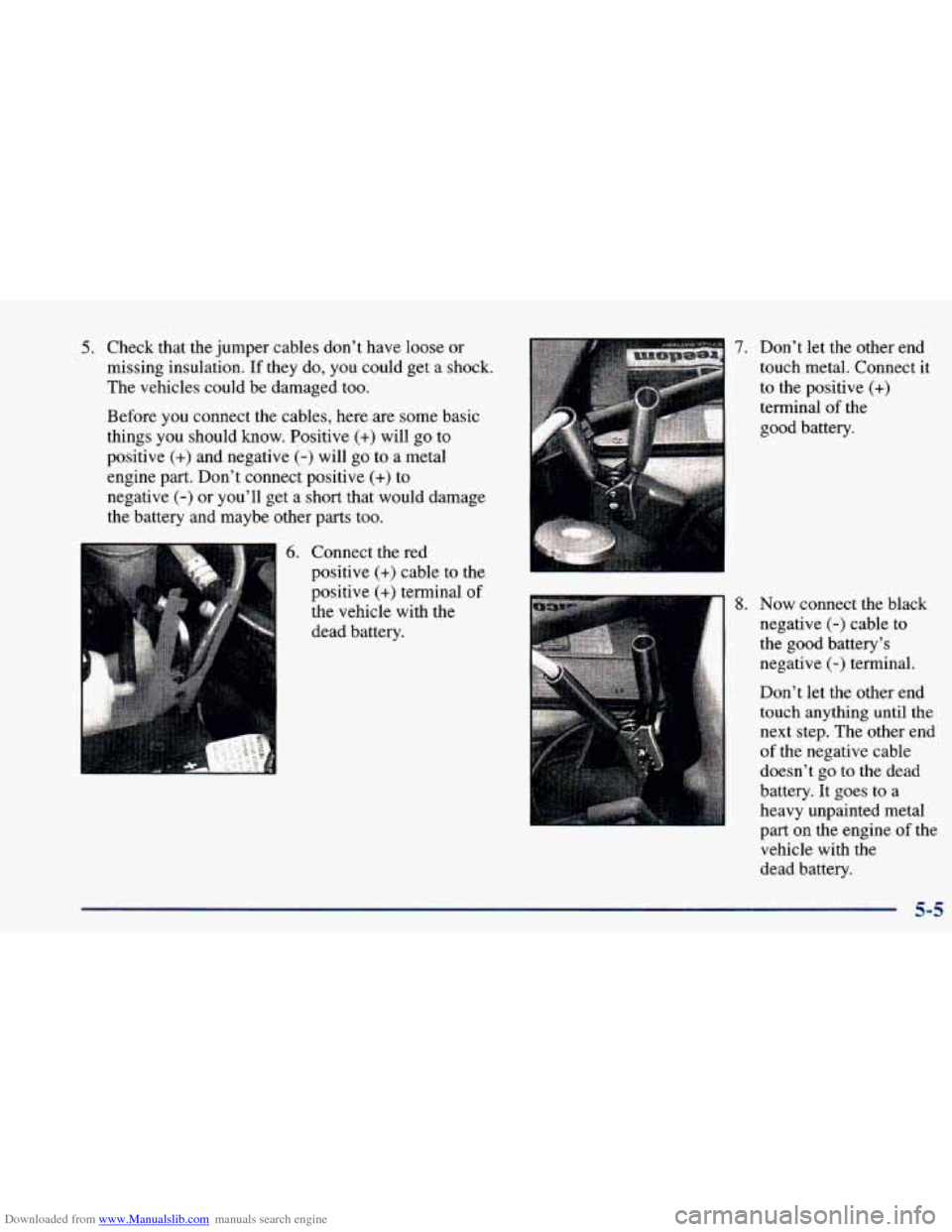
Downloaded from www.Manualslib.com manuals search engine 5. Check that the jumper cables don’t have loose or
missing insulation. If they do, you could get a shock.
The vehicles could be damaged too.
Before
you connect the cables, here are some basic
things you should know. Positive
(+) will go to
positive
(+) and negative (-) will go to a metal
engine
part. Don’t connect positive (+) to
negative
(-) or you’ll get a short that would damage
the battery and maybe other parts too.
6. Connect the red
positive
(+) cable to the
positive
(+) terminal of
the vehicle with the dead battery.
7. Don’t let the other end
touch metal. Connect it
to the positive
(+)
terminal of the
good battery.
8. Now connect the black negative
(-) cable to
the good battery’s negative
(-) terminal.
Don’t let the other end
touch anything until the next step. The other end
of the negative cable
doesn’t
go to the dead
battery. It goes to a
heavy unpainted metal
part on the engine
of the
vehicle with the
dead battery.
5-5
Page 238 of 416

Downloaded from www.Manualslib.com manuals search engine 9. Attach the cable at least
18 inches (45 cm) away
from the dead battery,
but not near engine parts
that move.
The electrical
connection is just as
good there, but the
chance
of sparks getting
back to the battery is
much less.
10. Now start the vehicle with the good battery and run
the engine for awhile.
11. Try to start the vehicle with the dead battery. If it
won’t start after a few tries, make sure all
connections are good. If it still won’t start, it
probably needs service.
Fans or other moving engine parts can injure you
badly. Keep your hands away from moving parts once the engiv is running.
12. Remove the cables in reverse order to prevent
electrical shorting. Take care that they don’t touch
each other or
any other metal.
A. Heavy Metal Engine Part
B. Good Battery
C. Dead Battery
5-6
Page 239 of 416
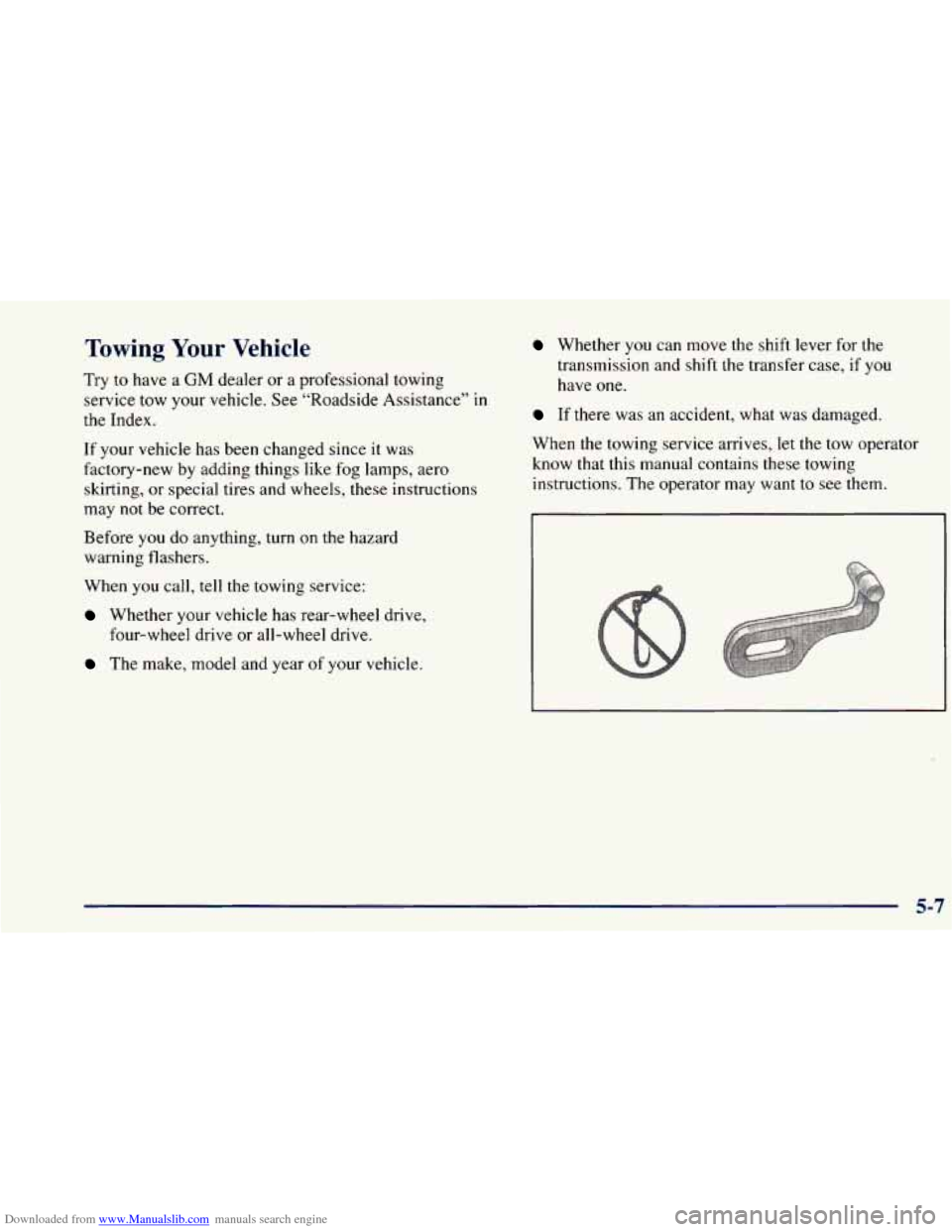
Downloaded from www.Manualslib.com manuals search engine Towing Your Vehicle
Try to have a GM dealer or a professional towing
service tow your vehicle. See “Roadside Assistance”
in
the Index.
If your vehicle
has been changed since it was
factory-new by adding things like fog lamps, aero
skirting, or special tires and wheels, these instructions
may not be correct.
Before you do anything, turn
on the hazard
warning flashers.
When you call, tell the towing service:
Whether your vehicle has rear-wheel drive,
four-wheel drive or all-wheel drive.
The make, model and year of your vehicle.
Whether you can move the shift lever for the
transmission and
shift the transfer case, if you
have one.
If there was an accident, what was damaged.
When the towing service arrives, let the tow operator
know
that this manual contains these towing
instructions. The operator may want to see them.
5-7
Page 240 of 416
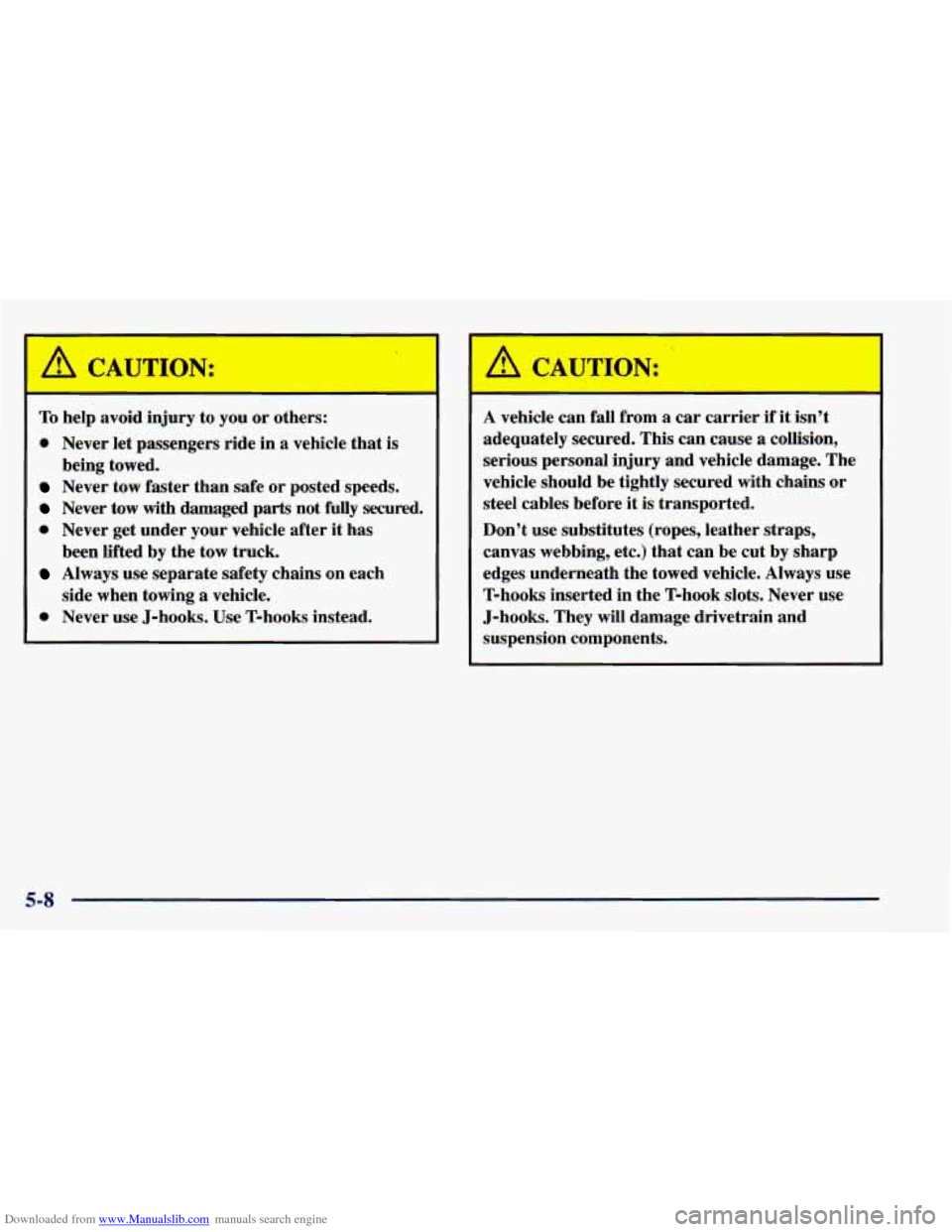
Downloaded from www.Manualslib.com manuals search engine I
’ A CAUTION:
To help avoid injury to you or others:
0 Never let passengers ride in a vehicle that is
Never tow faster than safe or posted speeds.
Never tow with damaged parts not fdy secured.
0 Never get under your vehicle after it has
Always use separate safety chains on each
0 Never use J-hooks. Use T-hooks instead. being towed.
been lifted
by the tow truck.
side when towing
a vehicle.
A vehicle can fall from a car carrier if it isn’t
adequately secured. This can cause
a collision,
serious personal injury and vehicle damage. The
vehicle should be tightly secured with chains or
steel cables before it is transported.
Don’t use substitutes (ropes, leather straps,
canvas webbing, etc.) that can be cut by sharp
edges underneath the towed vehicle. Always use
T-hooks inserted in the T-hook slots. Never use
J-hooks. They will damage drivetrain and
suspension components.
1
5-8